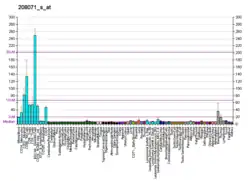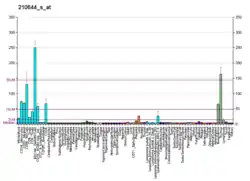LAIR1
Leukocyte-associated immunoglobulin-like receptor 1 is a protein that in humans is encoded by the LAIR1 gene.[5][6] LAIR1 has also been designated as CD305 (cluster of differentiation 305).
Function
The protein encoded by this gene is an inhibitory receptor found on peripheral mononuclear cells, including NK cells, T cells, and B cells.[7] Inhibitory receptors regulate the immune response to prevent lysis of cells recognized as self. The gene is a member of both the immunoglobulin superfamily and the leukocyte-associated inhibitory receptor family. The gene maps to a region of 19q13.4 called the leukocyte receptor cluster, which contains at least 29 genes encoding leukocyte-expressed receptors of the immunoglobulin superfamily.[6]
References
- ENSG00000276163, ENSG00000278154, ENSG00000274110, ENSG00000167613 GRCh38: Ensembl release 89: ENSG00000276053, ENSG00000276163, ENSG00000278154, ENSG00000274110, ENSG00000167613 - Ensembl, May 2017
- GRCm38: Ensembl release 89: ENSMUSG00000055541 - Ensembl, May 2017
- "Human PubMed Reference:". National Center for Biotechnology Information, U.S. National Library of Medicine.
- "Mouse PubMed Reference:". National Center for Biotechnology Information, U.S. National Library of Medicine.
- Meyaard L, Adema GJ, Chang C, Woollatt E, Sutherland GR, Lanier LL, Phillips JH (September 1997). "LAIR-1, a novel inhibitory receptor expressed on human mononuclear leukocytes". Immunity. 7 (2): 283–90. doi:10.1016/S1074-7613(00)80530-0. PMID 9285412.
- "Entrez Gene: LAIR1 leukocyte-associated immunoglobulin-like receptor 1".
- van der Vuurst de Vries AR, Clevers H, Logtenberg T, Meyaard L (October 1999). "Leukocyte-associated immunoglobulin-like receptor-1 (LAIR-1) is differentially expressed during human B cell differentiation and inhibits B cell receptor-mediated signaling". European Journal of Immunology. 29 (10): 3160–7. doi:10.1002/(SICI)1521-4141(199910)29:10<3160::AID-IMMU3160>3.0.CO;2-S. PMID 10540327.
- Fournier N, Chalus L, Durand I, Garcia E, Pin JJ, Churakova T, Patel S, Zlot C, Gorman D, Zurawski S, Abrams J, Bates EE, Garrone P (August 2000). "FDF03, a novel inhibitory receptor of the immunoglobulin superfamily, is expressed by human dendritic and myeloid cells". J. Immunol. 165 (3): 1197–209. doi:10.4049/jimmunol.165.3.1197. PMID 10903717.
- Sathish JG, Johnson KG, Fuller KJ, LeRoy FG, Meyaard L, Sims MJ, Matthews RJ (February 2001). "Constitutive association of SHP-1 with leukocyte-associated Ig-like receptor-1 in human T cells". J. Immunol. 166 (3): 1763–70. doi:10.4049/jimmunol.166.3.1763. PMID 11160222.
- Mousseau DD, Banville D, L'Abbé D, Bouchard P, Shen SH (February 2000). "PILRalpha, a novel immunoreceptor tyrosine-based inhibitory motif-bearing protein, recruits SHP-1 upon tyrosine phosphorylation and is paired with the truncated counterpart PILRbeta". J. Biol. Chem. 275 (6): 4467–74. doi:10.1074/jbc.275.6.4467. PMID 10660620.
- Xu Mj, Zhao R, Zhao ZJ (June 2000). "Identification and characterization of leukocyte-associated Ig-like receptor-1 as a major anchor protein of tyrosine phosphatase SHP-1 in hematopoietic cells". J. Biol. Chem. 275 (23): 17440–6. doi:10.1074/jbc.M001313200. PMID 10764762.
Further reading
- Sinclair NR (1999). "Why so many coinhibitory receptors?". Scand. J. Immunol. 50 (1): 10–3. doi:10.1046/j.1365-3083.1999.00580.x. PMID 10404045. S2CID 10345478.
- Meyaard L (1999). "LAIR-1, a widely distributed human ITIM-bearing receptor on hematopoietic cells". Curr. Top. Microbiol. Immunol. Current Topics in Microbiology 244 and Immunology. 244: 151–7. doi:10.1007/978-3-642-58537-1_13. ISBN 978-3-540-65789-7. PMID 10453657.
- Meyaard L (2004). "Leukocyte associated Ig-like receptor (LAIR)". J. Biol. Regul. Homeost. Agents. 17 (4): 330–3. PMID 15065762.
- Poggi A, Tomasello E, Ferrero E, Zocchi MR, Moretta L (1998). "p40/LAIR-1 regulates the differentiation of peripheral blood precursors to dendritic cells induced by granulocyte-monocyte colony-stimulating factor". Eur. J. Immunol. 28 (7): 2086–91. doi:10.1002/(SICI)1521-4141(199807)28:07<2086::AID-IMMU2086>3.0.CO;2-T. PMID 9692876. S2CID 21655416.
- Meyaard L, Hurenkamp J, Clevers H, Lanier LL, Phillips JH (1999). "Leukocyte-associated Ig-like receptor-1 functions as an inhibitory receptor on cytotoxic T cells". J. Immunol. 162 (10): 5800–4. doi:10.4049/jimmunol.162.10.5800. PMID 10229813. S2CID 14882830.
- Poggi A, Pellegatta F, Leone BE, Moretta L, Zocchi MR (2000). "Engagement of the leukocyte-associated Ig-like receptor-1 induces programmed cell death and prevents NF-kappaB nuclear translocation in human myeloid leukemias". Eur. J. Immunol. 30 (10): 2751–8. doi:10.1002/1521-4141(200010)30:10<2751::AID-IMMU2751>3.0.CO;2-L. PMID 11069054.
- Sathish JG, Johnson KG, Fuller KJ, LeRoy FG, Meyaard L, Sims MJ, Matthews RJ (2001). "Constitutive association of SHP-1 with leukocyte-associated Ig-like receptor-1 in human T cells". J. Immunol. 166 (3): 1763–70. doi:10.4049/jimmunol.166.3.1763. PMID 11160222.
- Saverino D, Fabbi M, Merlo A, Ravera G, Grossi CE, Ciccone E (2002). "Surface density expression of the leukocyte-associated Ig-like receptor-1 is directly related to inhibition of human T-cell functions". Hum. Immunol. 63 (7): 534–46. doi:10.1016/S0198-8859(02)00409-3. PMID 12072189.
- Aoukaty A, Lee IF, Wu J, Tan R (2003). "Chronic active Epstein-Barr virus infection associated with low expression of leukocyte-associated immunoglobulin-like receptor-1 (LAIR-1) on natural killer cells". J. Clin. Immunol. 23 (2): 141–5. doi:10.1023/A:1022580929226. PMID 12757266. S2CID 31461585.
- Verbrugge A, de Ruiter T, Clevers H, Meyaard L (2003). "Differential contribution of the immunoreceptor tyrosine-based inhibitory motifs of human leukocyte-associated Ig-like receptor-1 to inhibitory function and phosphatase recruitment". Int. Immunol. 15 (11): 1349–58. doi:10.1093/intimm/dxg134. PMID 14565933.
- De Milito A, Nilsson A, Titanji K, Thorstensson R, Reizenstein E, Narita M, Grutzmeier S, Sönnerborg A, Chiodi F (2004). "Mechanisms of hypergammaglobulinemia and impaired antigen-specific humoral immunity in HIV-1 infection". Blood. 103 (6): 2180–6. doi:10.1182/blood-2003-07-2375. PMID 14604962.
External links
- LAIR1+protein,+human at the U.S. National Library of Medicine Medical Subject Headings (MeSH)
- Overview of all the structural information available in the PDB for UniProt: Q6GTX8 (Leukocyte-associated immunoglobulin-like receptor 1) at the PDBe-KB.
This article incorporates text from the United States National Library of Medicine, which is in the public domain.





